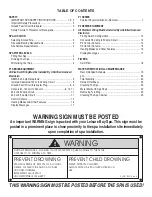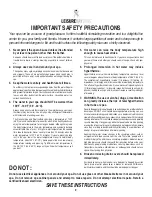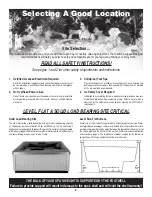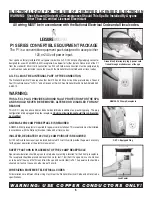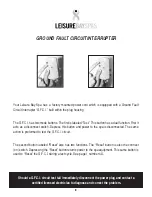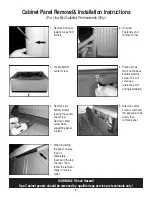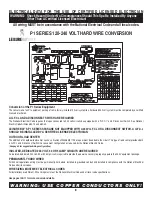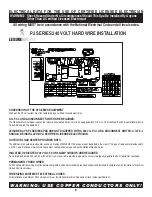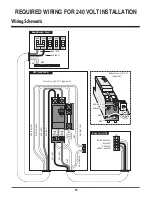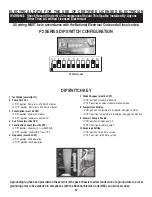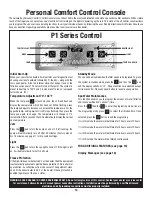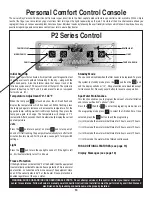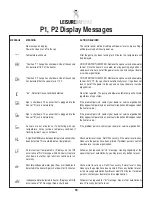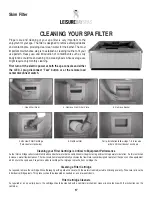
1. Never permit the spa to be used unless it is attended
by at least one person other than the bather.
Someone should be present to lend assistance if the bather should be in
trouble due to injuries, cramps, drowning especially in case of children,
etc.
2. Always use care in and around your spa.
The spa has many rigid, unyielding parts and many areas that become wet
and slippery. These all are potentially dangerous when rough play is
permitted or if care is not used, particularly when entering or leaving the
spa.
3. Keep the water sanitary and healthful at all times.
Your filter system will remove suspended particles from the water. Regular
application of spa chemicals in proper quantities will destroy harmful bacteria
and prevent formation of algae. Your surface skimmer will remove insects,
leaves, and other debris from the water surface. Unsanitary water is a
serious health hazard.
4. The water in your spa should NOT be warmer than
100°F - 104°F (38° - 40°C).
Always keep an accurate thermometer in the water because your spa’s
thermostat may be in error. Use a high quality, shatterproof thermometer
with increments of one degree or less.
The National Spa and Pool Institute considers a temperature of 100°F
(38°C) safe and comfortable for a healthy adult. Most healthy adults can
enjoy this water temperature for as long as desired, although it may raise
the body temperature to the water temperature and eventually become
uncomfortable (like a fever). At higher water temperatures the soaking
time should be shorter. Never soak for more than 20 minutes when the
water temperature is 102°F (39°C) or higher. If you are planning a long
rest in the spa, lower the water temperature closer to normal body
temperature, about 99°F (37.2°C). Some people find even lower water
temperatures relaxing and pleasing. Try different water temperatures in
the 98°-102°F (36.6°-39°C) range until you find what temperatures suit
you best.
5. Hot water can raise the body temperature high
enough to cause heat stroke.
This can be fatal even to healthy adults. If you have any questions about
your own fitness or whether you should soak in the spa, check with your
physician.
6. Prolonged immersion in hot water may induce
hyperthermia.
Hyperthermia occurs when internal body temperature reaches a level
several degrees above the normal body temperature of 98.6°F (36.6°C).
The symptoms of hyperthermia include: (1) dizziness, (2) fainting, (3)
drowsiness, (4) lethargy and (5) increase in the internal body temperature.
The effects of hyperthermia include: (1) unawareness of impending hazard,
(2) failure to perceive heat, (3) failure to recognize the need to exit spa, (4)
physical inability to exit spa and (5) unconsciousness resulting in danger
of drowning.
7. WARNING-The use of alcohol, drugs or medication
can greatly increase the risk of fatal hyperthermia
in hot tubs or spas.
Despite the popular image of people in spas drinking wine or other alcoholic
beverages, DO NOT use alcoholic beverages before or during spa use.
Alcohol and certain drugs and medications, are depressants which cause
slowed reflexes and drowsiness, especially in conjunction with the relaxed
soaking in hot water. This can lead to sleep or unconsciousness and possibly
result in drowning. Using your spa with other people who are also drinking
or under the influence of drugs or medications is not a preventative measure
since they are likely to become similarly affected by the combinations of
alcohol, drugs or medication and hot water soaking.
Soaking in hot water causes changes in the circulatory system, such as
enlargement of blood vessels near the skin. Therefore, people with a
medical history of heart disease, circulatory problems, diabetes, low or
high blood pressure should check with their physician before using spas.
Additionally, people taking medications causing drowsiness, such as
tranquilizers, narcotics, antihistamines, or anticoagulants should not use
spas without asking their physician.
8. Broken or missing drain covers should be replaced
immediately.
Accidents can occur when long hair or a body part is trapped by suction
from a drain or outlet whose cover is broken or removed. Children are
particularly vulnerable, and they should be warned against danger.
Your spa can be a source of great pleasure. It offers healthful stimulating recreation and is a delightful fun
center for you, your family and friends. However, it contains large quantities of water and is deep enough to
present inherent dangers to life and health unless the following safety rules are strictly observed.
IMPORTANT SAFETY PRECAUTIONS
DO NOT :
Do not use electrical appliances in or around your spa. Do not use glass or other breakable items in or around your
spa. Do not remove spa cabinet panels and attempt to make repairs. Do not attempt electrical repairs. Retain a
certified licensed electrician.
SAVE THESE INSTRUCTIONS
2
Summary of Contents for P1Series
Page 22: ...MAINTENANCE NOTES 20...
Page 23: ...MAINTENANCE NOTES 21...
Page 24: ...MAINTENANCE NOTES 22...
Page 25: ...MAINTENANCE NOTES 23...
Page 26: ...0007100 6 06...


